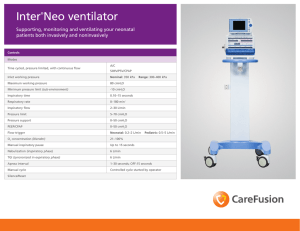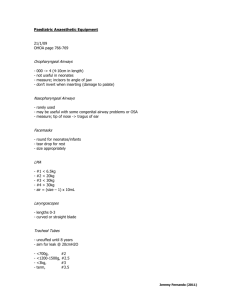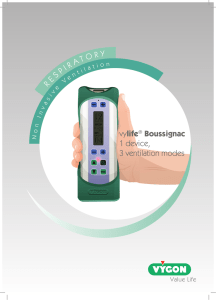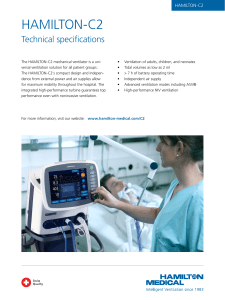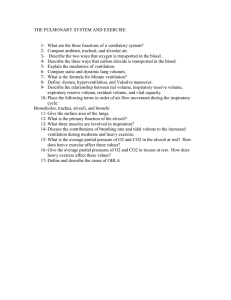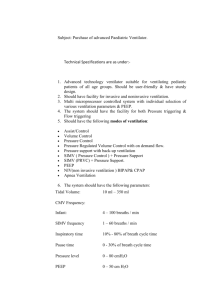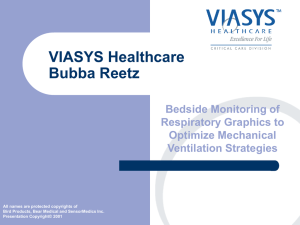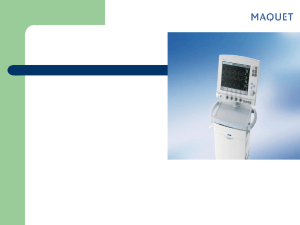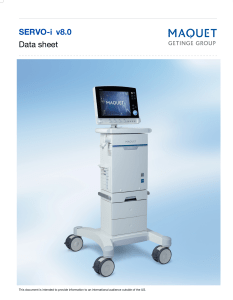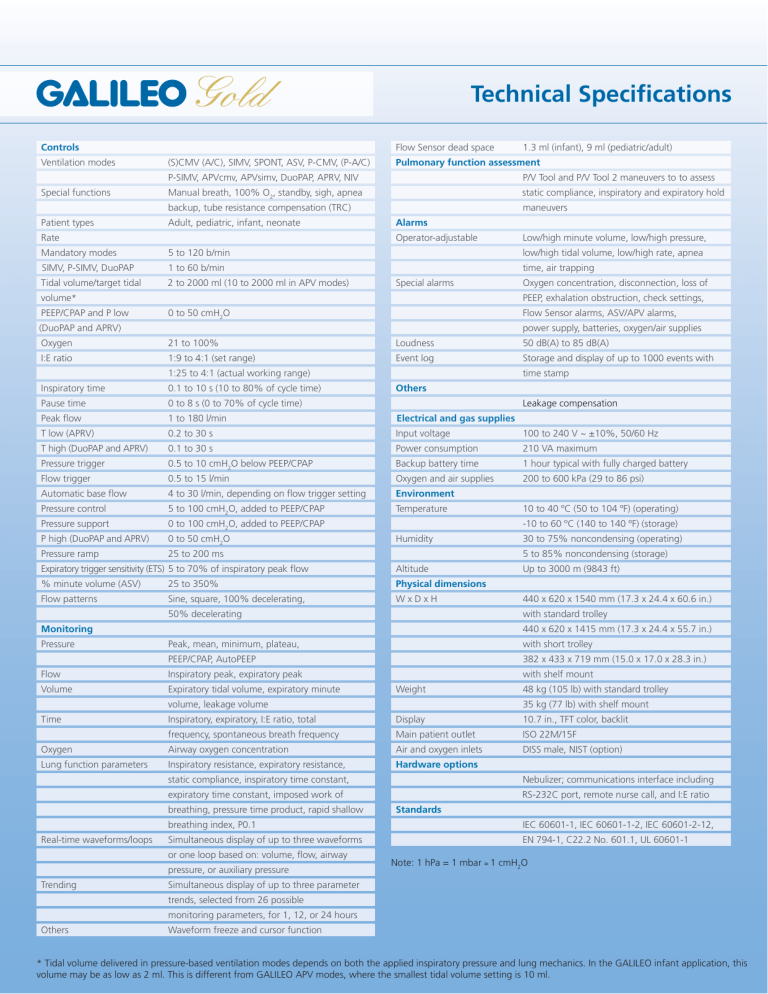
Technical Specifications Controls Ventilation modes Special functions Flow Sensor dead space (S)CMV (A/C), SIMV, SPONT, ASV, P-CMV, (P-A/C) P-SIMV, APVcmv, APVsimv, DuoPAP, APRV, NIV P/V Tool and P/V Tool 2 maneuvers to to assess Manual breath, 100% O2, standby, sigh, apnea static compliance, inspiratory and expiratory hold backup, tube resistance compensation (TRC) Patient types 1.3 ml (infant), 9 ml (pediatric/adult) Pulmonary function assessment Adult, pediatric, infant, neonate Rate maneuvers Alarms Operator-adjustable Low/high minute volume, low/high pressure, Mandatory modes 5 to 120 b/min low/high tidal volume, low/high rate, apnea SIMV, P-SIMV, DuoPAP 1 to 60 b/min time, air trapping Tidal volume/target tidal 2 to 2000 ml (10 to 2000 ml in APV modes) Special alarms volume* PEEP/CPAP and P low Oxygen concentration, disconnection, loss of PEEP, exhalation obstruction, check settings, 0 to 50 cmH2O Flow Sensor alarms, ASV/APV alarms, (DuoPAP and APRV) power supply, batteries, oxygen/air supplies Oxygen 21 to 100% Loudness 50 dB(A) to 85 dB(A) I:E I:E rrati atio o 1:9 to 4:1 (s 1:9 (set et ran range) ge) Event Event log log Stor Storage age and and disp display lay of up to 1000 1000 eve events nts with with 1:25 to 4:1 (actual working range) time stamp Others Inspiratory time 0.1 to 10 s (10 to 80% of cycle time) Pause time 0 to 8 s (0 to 70% of cycle time) Peak flow 1 to 180 l/min Electrical and gas supplies Leakage compensation T low (APRV) 0.2 to 30 s Input voltage 100 to 240 V ~ ±10%, 50/60 Hz T high (DuoPAP and APRV) 0.1 to 30 s Power consumption 210 VA maximum Pressure trigger 0.5 to 10 cmH2O below PEEP/CPAP Backup battery time 1 hour typical with fully charged battery Flow trigger 0.5 to 15 l/min Oxygen and air supplies 200 to 600 kPa (29 to 86 psi) Automatic base flow 4 to 30 l/min, depending on flow trigger setting Environment Pressure control 5 to 100 cmH2O, added to PEEP/CPAP Temperature Pressure support 0 to 100 cmH2O, added to PEEP/CPAP P high (DuoPAP and APRV) 0 to 50 cmH2O Pressure ramp 25 to 200 ms Humidity Altitude % minute volume (ASV) 25 to 350% Physical dimensions Sine, square, 100% decelerating, WxDxH 50% decelerating 440 x 620 x 1540 mm (17.3 x 24.4 x 60.6 in.) 440 x 620 x 1415 mm (17.3 x 24.4 x 55.7 in.) Peak, mean, minimum, plateau, with short trolley PEEP/CPAP, AutoPEEP 382 x 433 x 719 mm (15.0 x 17.0 x 28.3 in.) Flow Inspiratory peak, expiratory peak Volume Expiratory tidal volume, expiratory minute with shelf mount Weight volume, leakage volume Time Up to 3000 m (9843 ft) with standard trolley Monitoring Pressure 30 to 75% noncondensing (operating) 5 to 85% noncondensing (storage) Expiratory trigger sensitivity (ETS) 5 to 70% of inspiratory peak flow Flow patterns 10 to 40 ºC (50 to 104 ºF) (operating) -10 to 60 ºC (140 to 140 ºF) (storage) 48 kg (105 lb) with standard trolley 35 kg (77 lb) with shelf mount Inspiratory, expiratory, I:E ratio, total Display 10.7 in., TFT color, backlit frequency, spontaneous breath frequency Main patient outlet ISO 22M/15F Oxygen Airway oxygen concentration Air and oxygen inlets DISS male, NIST (option) Lung function parameters Inspiratory resistance, expiratory resistance, Hardware options static compliance, inspiratory time constant, Nebulizer; communications interface including expiratory time constant, imposed work of RS-232C port, remote nurse call, and I:E ratio breathing, pressure time product, rapid shallow Real-time waveforms/loops IEC 60601-1, IEC 60601-1-2, IEC 60601-2-12, Simultaneous display of up to three waveforms EN 794-1, C22.2 No. 601.1, UL 60601-1 or one loop based on: volume, flow, airway pressure, or auxiliary pressure Trending Standards breathing index, P0.1 Note: 1 hPa = 1 mbar 1 cmH2O Simultaneous display of up to three parameter trends, selected from 26 possible monitoring parameters, for 1, 12, or 24 hours Others Waveform freeze and cursor function * Tidal volume delivered in pressure-based ventilation modes depends on both the applied inspiratory pressure and lung mechanics. In the GALILEO infant application, this volume may be as low as 2 ml. This is different from GALILEO APV modes, where the smallest tidal volume setting is 10 ml. GALILEO ventilation modes (S)CMV (A/C) SIMV P-CMV (P-A/C) P-SIMV SPONT DuoPAP APRV NIV APVcmv APVsimv ASV Description Type (Synchronized) controlled mandatory ventilation Synchronized intermittent mandatory ventilation Pressure-controlled mandatory ventilation Pressure-controlled synchronized intermittent mandatory ventilation Pressure support ventilation Dual positive airway pressure Airway pressure release ventilation Noninvasive ventilation Adaptive pressure ventilation + controlled mandatory ventilation Adaptive pressure ventilation + synchronized intermittent mandatory ventilation Adaptive support ventilation Volume Volume Pressure Pressure Pressure Pressure Pressure Pressure Adaptive Adaptive Adult Adaptive Patient age group Pediatric GALILEO monitoring parameters Parameter Ppeak Pmean Pminimum Pplateau PEEP/CPAP Insp Flow Exp Flow VTE ExpMinVol VLeak I:E fTotal FSpont TI TE Oxygen Cstat P01 AutoPEEP PTP RCexp RCinsp Rexp Rinsp RSB WOBimp Type Pressure Pressure Pressure Pressure Pressure Flow Flow Volume Volume Volume Time Time Time Time Time Oxygen Lung mechanics Lung mechanics Lung mechanics Lung mechanics Lung mechanics Lung mechanics Lung mechanics Lung mechanics Lung mechanics Lung mechanics Unit cmH2O cmH2O cmH2O cmH2O cmH2O l/min l/min ml ml ml b/min b/min s s % ml/cmH2O cmH2O cmH2O cmH2O*s s s cmH2O/l/s cmH2O/l/s 1/l*min J/l Description Peak airway pressure Mean airway pressure Minimum airway pressure Plateau airway pressure Positive-end expiratory pressure / continuous positive airway pressure Peak inspiratory flow Peak expiratory flow Expiratory tidal volume Expiratory minute volume Leakage volume at the airway Inspiratory : expiratory ratio Total breathing frequency Spontaneous breathing frequency Inspiratory time Expiratory time Airway oxygen concentration (FiO2) Static compliance Airway occlusion pressure AutoPEEP or intrinsic PEEP Pressure time product Expiratory time constant Inspiratory time constant Expiratory flow resistance Inspiratory flow resistance Rapid shallow breathing index Imposed work of breathing HAMILTON MEDICAL AG, Via Crusch 8, CH-7402 Bonaduz, Switzerland (+41) 81 660 60 10 (+41) 81 660 60 20 info@hamilton-medical.com, www.hamilton-medical.com, www.IntelligentVentilation.org HAMILTON MEDICAL, Inc., 4990 Energy Way, P.O. Box 30008, Reno, NV 89520 USA (775) 858-3200, (800) 426-6331 (775) 856-5621, marketing@hamiltonmedical.net Infant 689155/06 Specifications are subject to change without notice. ASV, P/V Tool, and DuoPAP are tademarks of HAMILTON MEDICAL. © HAMILTON MEDICAL AG 2006. All rights reserved. Mode
